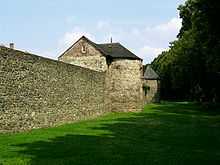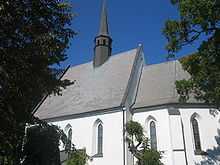Polička
| Polička | |||
| Town | |||
 | |||
|
|||
| Country | Czech Republic | ||
|---|---|---|---|
| Region | Pardubice | ||
| District | Svitavy | ||
| Municipality | Polička | ||
| River | Bílý potok | ||
| Elevation | 555 m (1,821 ft) | ||
| Coordinates | 49°42′54″N 16°16′3″E / 49.71500°N 16.26750°E | ||
| Area | 33.11 km2 (12.78 sq mi) | ||
| Population | 8,922 (2012-01-01) | ||
| Density | 269 / km2 (697 / sq mi) | ||
| Founded | 1265 | ||
| Mayor | Jaroslav Martinů | ||
| Timezone | CET (UTC+1) | ||
| - summer (DST) | CEST (UTC+2) | ||
| Postal code | 572 01 | ||
  Location in the Czech Republic
| |||
| Wikimedia Commons: Polička | |||
| Statistics: statnisprava.cz | |||
| Website: www.policka.org | |||
Polička (Czech pronunciation: [ˈpolɪtʃka]; German: Politschka) is a town on the Bohemia-Moravia borderline in the Pardubice Region of the Czech Republic. The population is 8,922 (as of January 1, 2012), and it lies about 17 km (11 mi) west of Svitavy. The elevation of the town is 555 m.
History
Polička was founded in 1265 by Bohemian King Ottokar II of Bohemia.
The name of the land Na políčkách (On the Fields) appeared for the first time in the list of places which, in 1167, King Vladislaus II of Bohemia put under the administration of the Praemonstratensian monastery in Litomyšl. Gradually, a settlement was built there in order to defend the country's trading route, leading from Moravia to Bohemia through dense forests.

On September 27, 1265, King Přemysl Ottokar II issued a decree in which he ordered the Royal Administrator Conrad of Loewendorf to take proper care of "setting up our new town Na políčkách". Undoubtedly, Conrad's plan was the beginning of the basic ground plan which still exists: a trapezoid square with four corner streets leading to four gates surrounded with a complex of buildings confined into an elliptical shape.
In 1305, Polička was mentioned as a dowry town of Czech queens. It was Přemysl Ottokar II who first dedicated the town to his wife Kunhuta as a dowry. In the 14th century, Queen Eliška Rejčka was given the town as a forfeit for her dowry by her second husband King Rudolf of Habsburg. Later, the profit from the town's revenues remained part of the dowry of wives of members of the ruling family. Thus the regional dowry town of Polička entered history.

In the second half of the 14th century, the town streets were paved, stone houses built, and a stone wall with 19 bastions constructed around the town. The town wall was 2.5 meter thick, and on the outer side it was ten meters high. Outside of the town walls the fortification system was completed by a moat.
1421 was a critical year for Polička. First, it was taken by Jan Žižka and afterwards plundered by Hungarians under Sigismund. During the Hussite wars, it was part of the moderate Prague Town Union. During the rule of George of Poděbrady, the town strengthened its fortification system with four barbicans, protecting the town entrance, and a new moat.
Polička enjoyed the favour of the Jagiellon dynasty during their rule. Later, the town actively participated in the fight against Ferdinand I. When Ferdinand I got to power, Polička was punished by suspension of its rights, fined, and its real estate was confiscated. Twelve years later, the town had to purchase the property for additional money. According to the listing of houses conducted in royal towns in 1567, Polička had 200 houses in total.
In the 16th century, renaissance style buildings started to be built in the town. Examples of this style are St. Michal’s Church (constructed since 1576 by Ambrož Vlach – a builder of Italian descent) and a prism-shaped bell tower which is situated in the cemetery. In 1613, Polička was devastated by fire. Only the gothic town hall and the southwest part of the town were spared.
After the uprising of the estates the town lost some of its rights and privileges. Polička did not prosper well during the Thirty Years’ War either. In 1654 only 90 inhabitants were counted, which was one ninth of the population of the town from 70 years before.
The 17th century was a period of prosperity for the town which got rebuilt in a baroque style. In this period, a 22 meter high plague column (Czech: Morový sloup) was placed in the town square. The column was most probably designed by F.M. Kaňka and was created between 1727 and 1731. It was meant to show gratitude of the town that it was spared by the plague of 1713. The statues of F.M. Kaňka also decorate the fountain and other parts of the square. He is supposedly also one of the authors of the new town hall, which was built between 1739 and 1744.
Polička kept its baroque appearance until 1845 when it was hit by another fire. Only 2% of stone houses survived and even St. Jacob’s church had to be torn down. A new neo-gothic church (designed by Antonín Vach and František Schmoranz) was being built for a period of 12 years and was finally finished in 1865. The 1845 fire has considerably slowed down the development of the town. Due to this, the town walls were not torn down. Until today the town walls (which are 1220 long) surround the historical core of Polička. Unfortunately, the town gates have not been preserved as they were demolished before the 1845 fire.
During the second half of the 19th century the town experienced a significant cultural development. In this period a Slavic reading room, Kollár choir, amateur actors’ club Tyl, sport club Sokkol Museum club Palacký were active. In 1890 classical music composer Bohuslav Martinů was born on the top of the church tower. Since September 1896 Polička has been connected to the national railway network. This started the industrial development of the town.
In the first half of the 20th century a number of significant building were built in the town, for example Tyl House (Czech: Tylův dům), Sokol Gymnasium (Czech: Sokolovna) or the building of the current secondary grammar school. Until 1918, Polička (Politschka before 1870) was part of the Austrian monarchy (Austria side after the compromise of 1867), in the district of the same name, one of the 94 Bezirkshauptmannschaften in Bohemia.[1] In October and November 1938 Polička was without justification occupied by Nazi Germany. In between 1939 and 1945 the town belonged to the Protectorate of Bohemia and Moravia.
After the WWII the town lost about thousand inhabitants which left to the abandoned areas from where the original German population was moved. In the post-war period the priority was given to the finalization of the sewerage system, construction of the water pipeline system and intensive development of housing. Immediately after 1948 Czechoslovak coup d'état, all significant factories got into the control of the state. Later even family shops were nationalized.
In the 1960 station administration reform Polička District became a part of Svitavy District and Polička ceased to be a district capital. In the second half of the 20th century new housing developments were built in the outskirts of the town.
Subdivisions
- Horní Předměstí
- Dolní Předměstí
- Polička-Město
- Lezník
- Střítež
- Modřec
People
Remarkable people who were born / lived in Polička are:
- Martin Doktor
- Kamila Hájková
- Josef Kubásek
- Bohuslav Martinů music composer 1890-1959
- Arne Novák
- Jewish pedigrees of Pol(l)itz(er), Pul(l)itz(er), etc.
- Otakar Sedloň, born at a village near here
Twin towns — Sister cities
Polička is twinned with:
Photo Gallery
-

The St. Jacob's church tower
-

The town hall
References
- ↑ Die postalischen Abstempelungen auf den österreichischen Postwertzeichen-Ausgaben 1867, 1883 und 1890, Wilhelm KLEIN, 1967
External links
| Wikimedia Commons has media related to Polička. |

